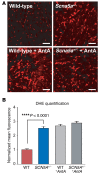A common variant alters SCN5A-miR-24 interaction and associates with heart failure mortality
- PMID: 29457789
- PMCID: PMC5824852
- DOI: 10.1172/JCI95710
A common variant alters SCN5A-miR-24 interaction and associates with heart failure mortality
Abstract
SCN5A encodes the voltage-gated Na+ channel NaV1.5 that is responsible for depolarization of the cardiac action potential and rapid intercellular conduction. Mutations disrupting the SCN5A coding sequence cause inherited arrhythmias and cardiomyopathy, and single-nucleotide polymorphisms (SNPs) linked to SCN5A splicing, localization, and function associate with heart failure-related sudden cardiac death. However, the clinical relevance of SNPs that modulate SCN5A expression levels remains understudied. We recently generated a transcriptome-wide map of microRNA (miR) binding sites in human heart, evaluated their overlap with common SNPs, and identified a synonymous SNP (rs1805126) adjacent to a miR-24 site within the SCN5A coding sequence. This SNP was previously shown to reproducibly associate with cardiac electrophysiological parameters, but was not considered to be causal. Here, we show that miR-24 potently suppresses SCN5A expression and that rs1805126 modulates this regulation. We found that the rs1805126 minor allele associates with decreased cardiac SCN5A expression and that heart failure subjects homozygous for the minor allele have decreased ejection fraction and increased mortality, but not increased ventricular tachyarrhythmias. In mice, we identified a potential basis for this in discovering that decreased Scn5a expression leads to accumulation of myocardial reactive oxygen species. Together, these data reiterate the importance of considering the mechanistic significance of synonymous SNPs as they relate to miRs and disease, and highlight a surprising link between SCN5A expression and nonarrhythmic death in heart failure.
Keywords: Cardiology; Genetic variation; Genetics; Ion channels; Noncoding RNAs.
Conflict of interest statement
Figures





Comment in
-
SCN5A: the greatest HITS collection.J Clin Invest. 2018 Mar 1;128(3):913-915. doi: 10.1172/JCI99927. Epub 2018 Feb 19. J Clin Invest. 2018. PMID: 29457788 Free PMC article.
Similar articles
-
Variant Intronic Enhancer Controls SCN10A-short Expression and Heart Conduction.Circulation. 2021 Jul 20;144(3):229-242. doi: 10.1161/CIRCULATIONAHA.121.054083. Epub 2021 Apr 29. Circulation. 2021. PMID: 33910361
-
Sequencing of SCN5A identifies rare and common variants associated with cardiac conduction: Cohorts for Heart and Aging Research in Genomic Epidemiology (CHARGE) Consortium.Circ Cardiovasc Genet. 2014 Jun;7(3):365-73. doi: 10.1161/CIRCGENETICS.113.000098. Circ Cardiovasc Genet. 2014. PMID: 24951663 Free PMC article.
-
A heterozygous deletion mutation in the cardiac sodium channel gene SCN5A with loss- and gain-of-function characteristics manifests as isolated conduction disease, without signs of Brugada or long QT syndrome.PLoS One. 2013 Jun 28;8(6):e67963. doi: 10.1371/journal.pone.0067963. Print 2013. PLoS One. 2013. PMID: 23840796 Free PMC article.
-
The role of mutations in the SCN5A gene in cardiomyopathies.Biochim Biophys Acta. 2016 Jul;1863(7 Pt B):1799-805. doi: 10.1016/j.bbamcr.2016.02.014. Epub 2016 Feb 23. Biochim Biophys Acta. 2016. PMID: 26916278 Review.
-
Dysfunctional Nav1.5 channels due to SCN5A mutations.Exp Biol Med (Maywood). 2018 Jun;243(10):852-863. doi: 10.1177/1535370218777972. Epub 2018 May 27. Exp Biol Med (Maywood). 2018. PMID: 29806494 Free PMC article. Review.
Cited by
-
A common variant in PIK3CG gene associated with the prognosis of heart failure.J Cell Mol Med. 2024 Sep;28(17):e70069. doi: 10.1111/jcmm.70069. J Cell Mol Med. 2024. PMID: 39245801 Free PMC article.
-
SCN5A: the greatest HITS collection.J Clin Invest. 2018 Mar 1;128(3):913-915. doi: 10.1172/JCI99927. Epub 2018 Feb 19. J Clin Invest. 2018. PMID: 29457788 Free PMC article.
-
Voltage-Gated Sodium Channels: A Therapeutic Target in Ischemic Heart Disease.Rev Cardiovasc Med. 2025 Jun 26;26(6):27140. doi: 10.31083/RCM27140. eCollection 2025 Jun. Rev Cardiovasc Med. 2025. PMID: 40630435 Free PMC article. Review.
-
Modulation of the cardiac sodium channel NaV1.5 peak and late currents by NAD+ precursors.J Mol Cell Cardiol. 2020 Apr;141:70-81. doi: 10.1016/j.yjmcc.2020.01.013. Epub 2020 Mar 21. J Mol Cell Cardiol. 2020. PMID: 32209328 Free PMC article.
-
Genome-wide association studies of cardiac electrical phenotypes.Cardiovasc Res. 2020 Jul 15;116(9):1620-1634. doi: 10.1093/cvr/cvaa144. Cardiovasc Res. 2020. PMID: 32428210 Free PMC article. Review.
References
Publication types
MeSH terms
Substances
Grants and funding
LinkOut - more resources
Full Text Sources
Other Literature Sources
Medical
Molecular Biology Databases
Miscellaneous

